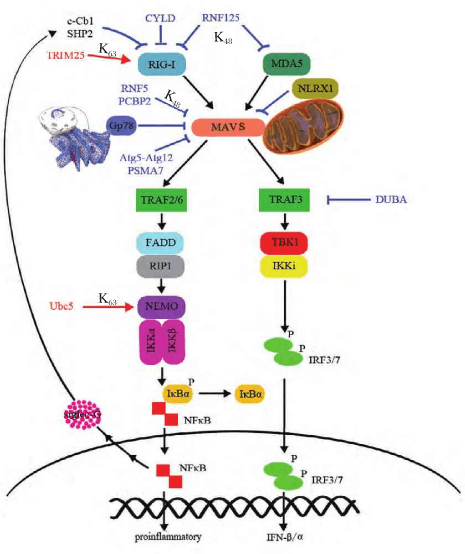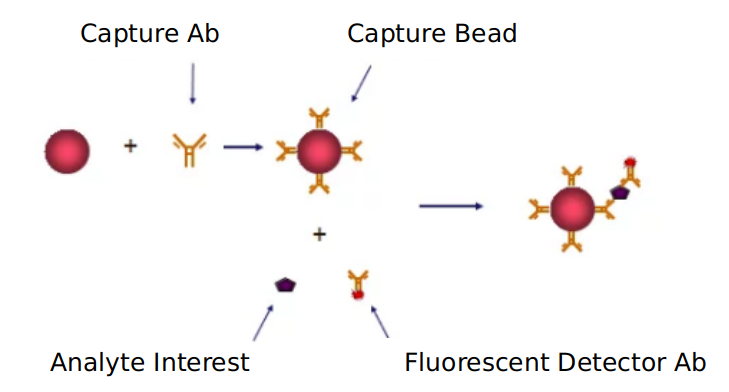Introduction to RIG-I-like receptor signaling pathway
Based on Luminex technology platform, Creative Proteomics provides analysis services for key targets of RIG-I-like receptor signaling pathway.
RIG-I-like receptors (retinoic acid-induced gene I-like receptors, RLR) are a family of molecules that are expressed in cells to sense viruses and belong to pattern recognition receptors for innate immunity. As a type of RNA helicase in the cytoplasm, they can recognize non-self viral RNA by combining their RNA ligands with pathogen-related molecular patterns. In infected cells, this interaction can trigger the fire activation of RLRs and downstream signaling molecules, which ultimately leads to the production of type I interferon and the production of inflammatory factors, and the cells make an antiviral immune response.
The members of the RIG-I-like receptor family mainly include three: RIG-I, MDA5, and LGP2. Among them, RIG-I is isolated from the human acute promyelocytic leukemia NB4 cell line and is the most stimulated by retinoic acid treatment. One of the genes involved in the body's innate immune response. RIG-I is a cytoplasmic protein. The N-terminus is two series-connected caspase activation recruitment domains (CARD), and the middle part is the RNA helicase domain, which contains the key sites for binding to ATP; the C-terminus is It is the domain that binds to RNA and the inhibitory domain, and the region in RIG-I that has RNA recognition and signal inhibition is called the C-terminal domain. RIG-I, MDA5, and LGP2 all have an RNA helicase domain containing a special DEX/DH box, which can bind to RNA and act as an ATPase to promote changes in RNA conception and activate downstream signal transduction.
In the antiviral signal pathway of RIG-I-like receptors, most of the reason is that RIG-I-like receptors can recognize viral components and induce the production of type 1 interferon, relying on its protein structure to transmit viral signals. The RIG-I-like receptor has three domains: the repeat domain (responsible for recognizing PAMPs), the transmembrane domain, and the TIR receptor domain that transmits activation signals. The TIR receptor domain can recruit TIR-containing domains. Adaptor proteins, such as TRIF and MyD88 are common adaptor proteins. RIG-I plays an important role in animal virus infection.

Our detectable targets:
| c-Cb1 | CYLD | RNF125 | K48 | MDA5 | NLRX1 |
| MAVS | Gp78 | K63 | TRAF2 | TRAF6 | TRAF3 |
| FADD | TBK1 | RIPI | NEMO | IKK-α | IKK-β |
| IkBα | NFκB | IRF3 | IRF7 | IKKi | |
| IFN-β |
Technology platform
We provide Luminex technology for RIG-I-like Receptor signaling pathway analysis.
Luminex technology is a multifunctional liquid phase analysis platform developed on the basis of colored microspheres, laser technology, applied fluidics and high-speed digital signal processing technology. The core is to encode polypropylene microspheres or magnetic microspheres with fluorescent dyes. By adjusting the different ratios of the two fluorescent dyes, up to 100 microspheres with different fluorescence spectra can be obtained. Each kind of microspheres is covalently cross-linked. Capture antibodies against specific antigens.
RIG-I-like receptors can recognize non-self viral RNA through its RNA ligand binding to pathogen-related molecular patterns. The activation of RIG-I depends on its ATP binding activity, and the C-terminal of RIG-I plays a vital role in regulating its activation. RIG-I plays an important role in animal virus infection.
In addition to Luminex Multiplex Assay, Enzyme-linked immunosorbent assay (ELISA), Flow cytometry (FACS analysis) technology can also be provided to meet other customer needs.
Advantages of RIG-I-like Receptor signaling pathway detection:
- High-throughput and high-speed: Each microsphere is used as a separate test body, which can perform a large number of biological tests at the same time. It only needs 10~201 samples to test up to 100 indicators at a time, and the fastest can reach 10,000 tests /hour.
- High flexibility: specific probes, antigens or antibodies can be connected to the microspheres to meet the needs of different customers.
- Good repeatability: similar homogeneous reaction mode, each indicator has 1000-5000 reaction units, and the median value of 100 analysis is taken. High accuracy: the detection range is 35-6 orders of magnitude, which is very strong with ELISA and mass spectrometry.

Application of our service:
- To study the effects of drugs or therapies on RIG-I-like receptor signaling pathways
- To study the effect of each virus on RIG-I-like receptor signaling pathway
- To study the regulation mechanism of RIG-I-like receptor signaling pathway in disease
Creative Proteomics has developed a signal pathway target detection platform. We are not limited to providing RIG-I-like receptor signaling path detection services, but can also provide other signal path detection services. If you want to detect other targets, please contact us and we will customize the service for you. Look forward to working with you.
References:
- LooY M, Gale M. Immune signaling by RIG-I-like receptors. Immunity, 2019, 34(5): 680-692.
- Yoneyama M, Kikuchi M, The RNA helicase RIG-I has an essential function in double-stranded RNA-induced innate antiviral responses. Nat Immunol, 2018, 5(7): 730-737.



